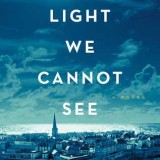
All the Light We Cannot See by Anthony Doerr
Positives
Negatives
“At dusk they pour from the sky. They blow across the ramparts, turn cartwheels over rooftops, flutter into the ravines between houses. Entire streets swirl with them, flashing white against the cobbles. Urgent message to the inhabitants of this town, they say. Depart immediately to open country.”
At what point do we abandon all expectations and focus, instead, on that which is purely righteous—that which pleases our individual souls and ignores the collective? The simple answer: we just don’t know until it happens. All the Light We Cannot See by Anthony Doerr is a novel with characters on the cusp of action, but they are waiting—waiting for that moment, that spark, that light.
Set during World War II, Doerr’s novel weaves between two primary plots. The first involves the life of Marie-Laure, a blind French girl. Marie-Laure lives with her father, and he challenges his daughter to explore and to create. She learns to read Braille books, and she studies a miniature of her neighborhood in order to navigate the streets on her own. Soon, the Nazis invade Paris, and Marie-Laure and her father must move. They flee to a tall home in Saint-Malo, where she joins her mysterious great-uncle. She is unable to carry most of her belongings, but she does bring a special jewel with power that makes her uneasy. She develops a connection with a radio, and it helps her broadcast her story even in the darkest of moments. As the dangers of the war pull her family away, Marie-Laure has to decide who she can trust and what she should do.
The sections about Marie-Laure are moving and having a fantastical sensibility. She cannot see her world, but it is one that she can feel. Doerr writes, “Marie-Laure shuffles along half-asleep. The road seems hardly wider than a path. The air smells like wet grain and hedge trimmings; in the lulls between their footfalls, she can hear a deep, nearly subsonic roar. She tugs her father to a stop. ‘Armies.’ ‘The Ocean.’” The senses of hearing and smell become heightened during Marie-Laure’s chapters; in fact, these characteristics of the world almost fulfill the role of another character. Combined, these sensibilities establish a world that we don’t just read about; we escape into it.
The second storyline centers on a German boy named Werner. Werner, unlike most of the boys in his hometown, has an interest in science and math. He and his sister, Jutta, develop a fascination with a radio, and it occupies much of their time. Together, they explore and create. The war soon pulls Werner away from Jutta and the rest of his family. Because of his talents, he joins a school for Hitler Youth. Again, Werner doesn’t fit in. He is too kind and too sensitive. His talent with radios helps him escape some of the harshness, but he is still very much a part of Hitler’s army. Eventually, Werner winds up in Saint-Malo, and this is where the two protagonists’ paths cross.
Doerr’s ability to render Werner as a dual protagonist who is as connected to his senses as Marie-Laure is to hers is remarkable. It is sound that gets Werner through his difficult days. Specifically, though, it is Marie-Laure’s broadcasted story—her words and voice—that reminds him of his morals. Because of her account, he realizes that he must make a decision to either continue on his path of destruction and violence or rekindle his closeness to the light. Marie-Laure is Werner’s light, and he is hers.
Doerr’s prose is rich and elegant. He chooses to create short chapters; most are only a page or two, with an occasional splurge into a handful. This effect gives the novel a very poetic feeling. As with any great poetry, the words are beautiful. Life is very much an object of beauty in All the Light We Cannot See:
“We all come into existence as a single cell, smaller than a speck of dust. Much smaller. Divide. Multiply. Add and subtract. Matter changes hands, atoms flow in and out, molecules pivot, proteins stitch together, mitochondria send out their oxidative dictates; we begin as a microscopic electrical swarm. The lungs the brain the heart. Forty weeks later, six trillion cells get crushed in the vise of our mother’s birth canal and we howl. Then the world starts in on us.”
Anthony Doerr’s All the Light We Cannot See is a treasure. The complex characters, the alive settings, the superb plotting, and the vivid prose all combine together to create a final product that is a true joy to unravel. Take your time unwrapping it; it’s one to savor.

